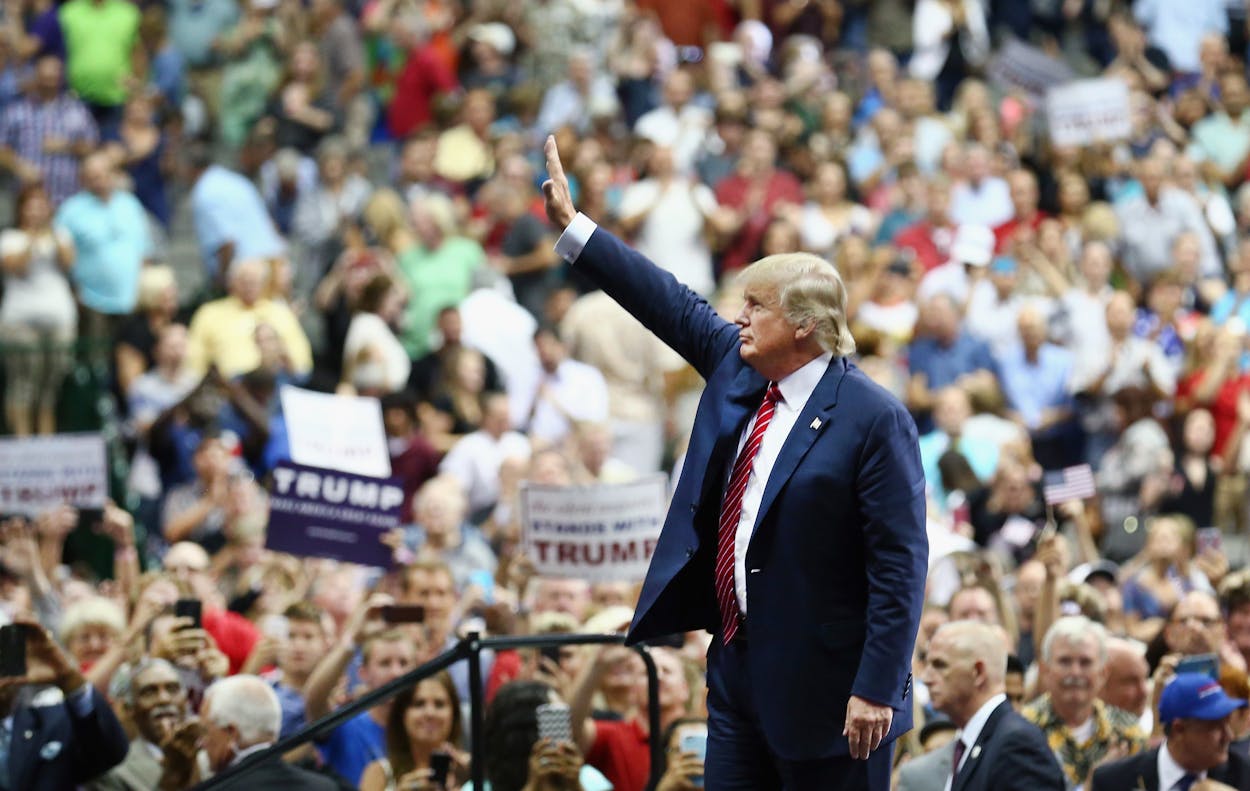On Monday, the Real Clear Politics site declared that Texas is up for grabs in the presidential election. The shift comes after a series of polls showing a tight race in the state between Hillary Clinton and Donald Trump, and makes for a dramatic image on the site’s election tracking map, where Texas is no longer colored its usual red but is now the dark gray that connotes a “toss up.” For Democrats, seeing their state change color on one of the most widely read and respected campaign outlets—after decades of Republican dominance and years of unfulfilled hopes that Texas might turn blue—must be cathartic. And it might be tempting to view this sudden shift to competitiveness as the start of Democrats’ long-hoped-for return to relevance, as a turning point.
Well, they should keep the cork in the champagne, because Texas remains a Republican state.
As my colleague R.G. Ratcliffe pointed out, the Texas polls are close not because of a huge spike in Democratic voters—Clinton’s numbers are roughly in line with Obama’s totals from 2008 and 2012—but because Trump’s support has cratered. He’s drastically under-performing previous Republican presidential nominees. John McCain and Mitt Romney garnered 55 percent and 57 percent of the vote in Texas, respectively. Trump is polling 10 to 12 points below that.
That isn’t just a Texas phenomenon: Other reliably Republican states like Utah, Arizona, and Georgia have also become competitive, and swing states like Virginia, Pennsylvania, and Colorado now appear out of reach for Trump.
All of which makes the close race in Texas look like a fluke—the product of a weak Republican candidate running a disastrous campaign.
Many Democrats may already know this, but for anyone tempted to misread this election as a sign that something is fundamentally shifting in Texas politics, let’s run through a few more reasons why this close race is likely fool’s gold.
For one, it was possible to predict that Trump’s nomination could make Texas competitive in the presidential election; in fact, our own Erica Grieder called it months ago.
It’s also telling that the state became a toss up only after Trump’s campaign began to meltdown from scandals probably too numerous to list here. You’ve no doubt read a story or two about them.
That seems to indicate that the free-falling Trump campaign has made Texas a close race rather than any particular action taken by Democrats (Clinton’s recent small television ad buy not withstanding).
While it’s true that the national GOP looks like a smoking ruin right now, the state party remains fairly strong. It still has huge advantages over Texas Democrats in money, organization, and candidate depth, and Republicans start every statewide race with at least a ten-point edge, if not more. And if you’re thinking that built-in advantage may be shrinking, keep in mind that we’re just two years removed from an across-the-board Republican blowout of nearly 20 points. In Wendy Davis, the Democrats had their best known and best funded candidate in years, and she lost to Greg Abbott by nearly a million votes.
It’s also worth remembering that most statewide offices in Texas come up for election in non-presidential years in which the electorate generally tends to be whiter and older—in other words, more Republican.
The one caveat is the potential increase in Latino voters. R.G. wrote on Monday that more than 530,000 people with Latino surnames have registered to vote since 2012, according to the Texas secretary of state’s office. It’s not hard to envision Trump’s candidacy increasing the number of Latino voters who turn out to vote in Texas, offering Democrats the opportunity to begin building a coalition that could one day make them competitive again. But capitalizing on that opportunity requires the difficult party-building, community-organizing, voter-turnout work that Democrats in this state haven’t exactly excelled at in recent years.
In other words, two years from now—without Trump at the top of the ticket—Texas Republicans will once again be heavily favored to sweep the statewide offices.
So Texas Democrats should enjoy the moment. They should have a long, satisfied look at that Real Clear Politics map, maybe take a screen shot of it, because it’s not likely to last.






